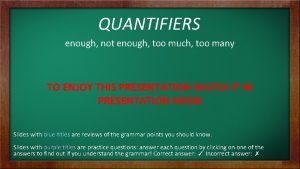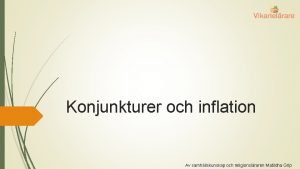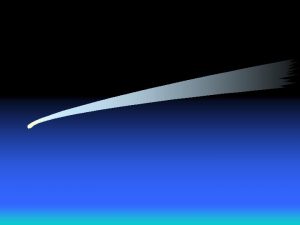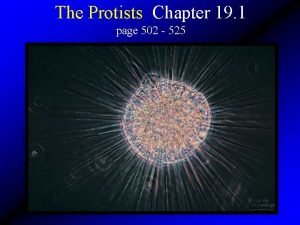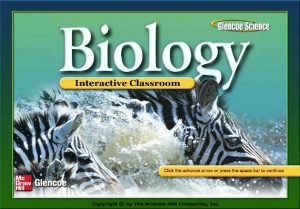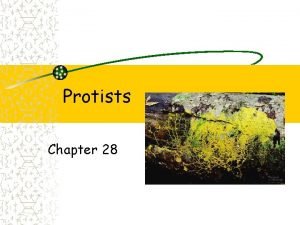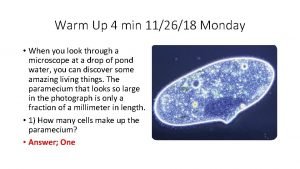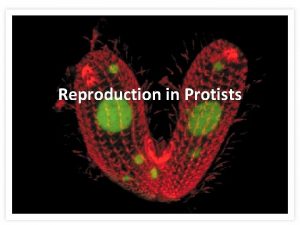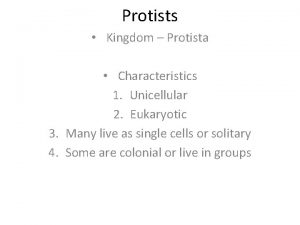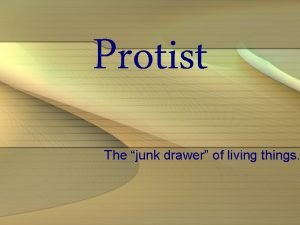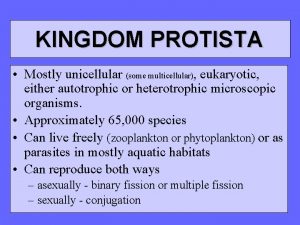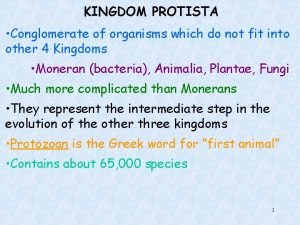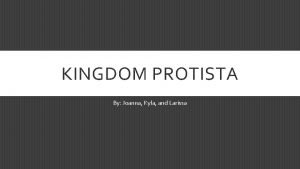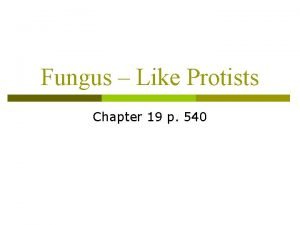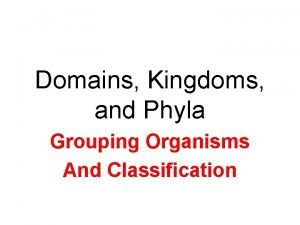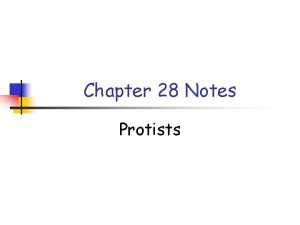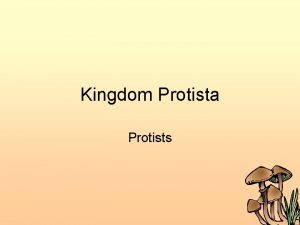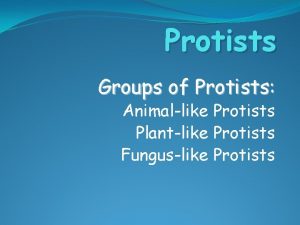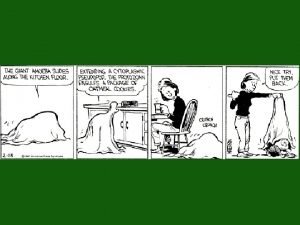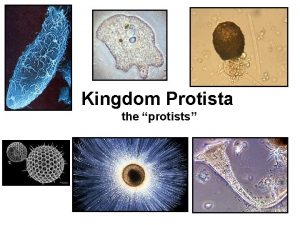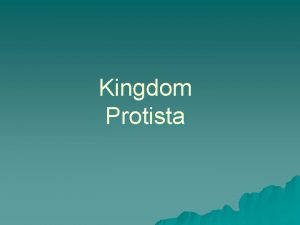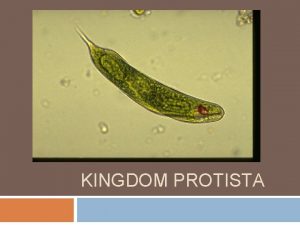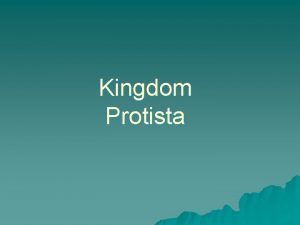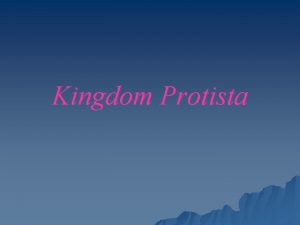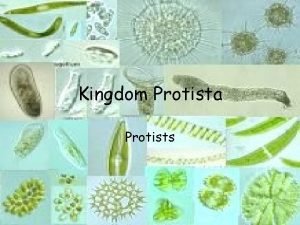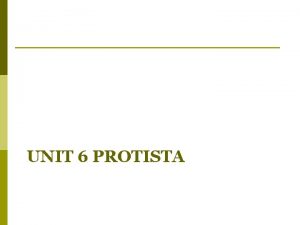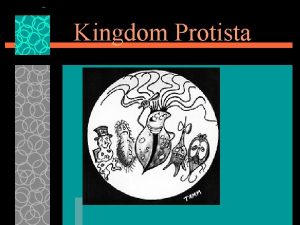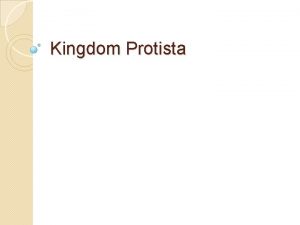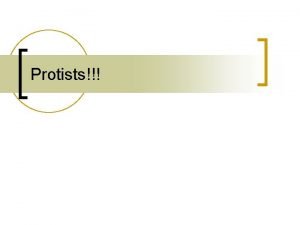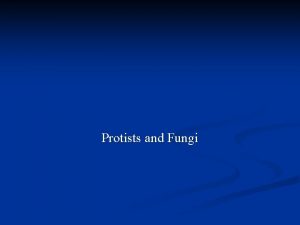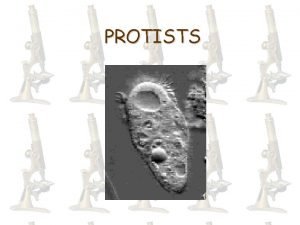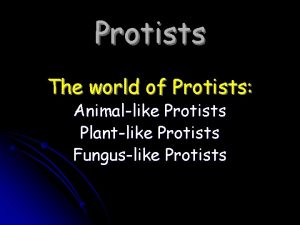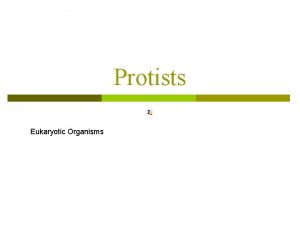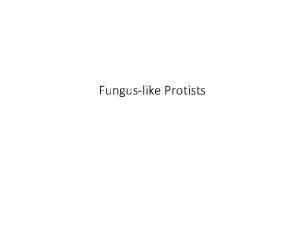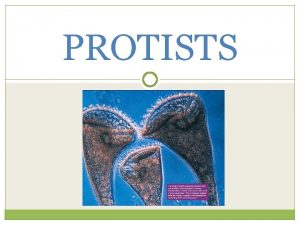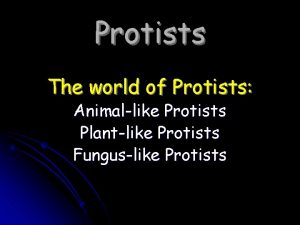Chapter 11 Protists Protista Protists Some are too



































- Slides: 35

Chapter 11 Protists

Protista (Protists) Some are too tiny to be seen without a microscope while others are meters long Some are like animals, plants or fungi

General Characteristics All are eukaryotic, have nuclei Most are single celled but some are multi cellular Scientists believe more complex organisms originated from protists

Protists Producers- get food through photosynthesis Consumers- get food from other sources Grouped by how they get food into 3 groups

Funguslike Protists Get food from dead organic matter Secrete juices into the food source and absorb the digested nutrients Reproduce like fungus

Slime Mold Thin masses of living matter Colorful, shapeless globs of slime Live as single celled organisms, but congregate in times of stress

Slime molds Live in cool, shady moist places in the woods and fresh water Eat bacteria, yeast, small bits of decaying plants and animal matter

Unfavorable Conditions Slime molds develop stalklike structures with rounded knobs at the top (spores) The spores can survive a long time without nutrients until conditions improve


Water Molds Most are small and single celled Live in water, moist soil or other organisms Decomposers or parasites Caused the Great Potato Famine


Plantlike Protists Producers Algae (alga) have chlorophyll (pigment for photosynthesis) and other pigments Almost all live in water

Seaweed or Kelp Multicellular algae Live near the shore Can grow to be meters in length

Phytoplankton Single celled algae Usually float near the surface Produce most of the world’s oxygen Divided into phyla based on color and cell structure


Algin and Carageenan 2 substances extracted from algae used in many foods Including ice cream , salad dressing, jelly beans and instant pudding

Volvox An example specimen of green algae Single celled but live in colonies You will see in lab


Diatoms Single celled, unusual shapes Found in salt and fresh water Contain silica (a glass-like substance) and cellulose Used in tooth paste and silver polish


Dinoflagellates Single celled, live primarily in salt water, Have 2 flagella, whip-like strand used for movement Some are red and produce a poison which can cause red tides If fish eat enough of the poison, they can be toxic to humans


Euglenoids Single celled, live in fresh water, characteristics of plants and animals Use photosynthesis and consume food Have one flagella (whip-like tail) and contractile vacuoles


Animal-like Protists Protozoa Grouped into 4 categories Amoebalike protists Flagellates Cilliates Spore forming protists

Amoebalike protists Soft jelly-like, contractile vacuoles Move with psuedopodia (false feet) Feed by engulfing food Include Foraminiferans and Radiolarians (amoeba like with shells)


Flagellates Flagella for movement Parasites Giardia lamblia found in water, affects hikers when drinking untreated water Another lives in the guts of termites to help them digest the cellulose in wood


Cilliates Most complex protozoans Covered in tiny hair-like projections called cillia used for movement and feeding Best known is Paramecium


Spore-Forming Protists Parasites, no cillia or flagella present so they can’t move on their own Have complicated life cycles Malaria caused by Plasmodia vivax


Reproduction of Protists Asexual – one parent Fission- dividing of parent into 2 organisms Euglena and Amoeba Sexual – 2 parents Conjugation – swap DNA and then divide Paramecium

 Insidan region jh
Insidan region jh Too enough kahoot
Too enough kahoot Too broad and too narrow examples
Too broad and too narrow examples Being too broad
Being too broad Too broad and too narrow examples
Too broad and too narrow examples Too much money is chasing too few goods
Too much money is chasing too few goods Too broad and too narrow examples
Too broad and too narrow examples Just right scale
Just right scale Here you are too foreign for home
Here you are too foreign for home Too anointed to be disappointed
Too anointed to be disappointed They say it only takes a little faith
They say it only takes a little faith They say it only takes a little faith to move a mountain
They say it only takes a little faith to move a mountain Ice cream count or noncount
Ice cream count or noncount Contact and non contact forces
Contact and non contact forces Some say the world will end in fire some say in ice
Some say the world will end in fire some say in ice Some say the world will end in fire some say in ice
Some say the world will end in fire some say in ice Some may trust in horses
Some may trust in horses Sexual reproduction in paramecia is called _____.
Sexual reproduction in paramecia is called _____. Chapter 19 protists worksheet answers
Chapter 19 protists worksheet answers Archaeplastid
Archaeplastid Odds and ends kingdom
Odds and ends kingdom What are protists lesson outline
What are protists lesson outline Is mitosis asexual
Is mitosis asexual Protista ex
Protista ex Introduction of protista
Introduction of protista Why is protista the junk drawer of kingdoms
Why is protista the junk drawer of kingdoms Kingdom fungi and kingdom plantae similarities
Kingdom fungi and kingdom plantae similarities Protists unicellular or multicellular
Protists unicellular or multicellular Are protists eukaryotic
Are protists eukaryotic Animal like protists definition
Animal like protists definition Animal like protists
Animal like protists Fungus like protists
Fungus like protists Protist brainpop answers
Protist brainpop answers 3 domain 6 kingdom
3 domain 6 kingdom Are protists unicellular or multicellular
Are protists unicellular or multicellular Structural and functional diversity in protists
Structural and functional diversity in protists

